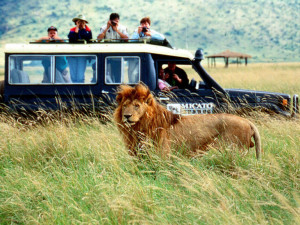Safari in Africa
It is thought that safaris as we know them now, i.e. hunting wild animals, started as long ago as the nineteenth century, the term being coined by Captain Sir Richard Francis Burton, the English explorer, when gentlemen of a certain class took pleasure in killing beasts in their natural habitat, in order to prove their manhood and bag a trophy for the library wall.
 Nowadays, thankfully, there are few amongst us who would consider slaughtering the wonderful creatures of Africa as a sport, but we still like to experience the adventure of hunting them down in order to watch them in the wild.
Nowadays, thankfully, there are few amongst us who would consider slaughtering the wonderful creatures of Africa as a sport, but we still like to experience the adventure of hunting them down in order to watch them in the wild.
Most people are keen to see the “Big Five” – elephant, rhinoceros, buffalo, lion and leopard. Why the graceful giraffes and antelopes and cheetahs, the fastest creatures on earth, are left out of this revered group is a mystery, but that’s the way it goes. In addition to the mammals, there is also a fantastic array of colourful bird life as well as butterflies and insects, so never a dull moment on safari.
Uganda is much improved, having recovered from the depredations of Idi Amin and you can risk Zimbabwe if you want but the best safariing is to be found in Kenya, Tanzania, Botswana and South Africa. Within these countries, there are many different game parks or reserves, each with a special character or attraction and often a different group of resident animals. For example, the Serengeti National Park/Ngorongoro Conservation Area is famous for the enormous herds of wildebeest, zebra and antelope where the calves are born before the grazing runs out and the herds move on. In Kenya, Tsavo East National Park is renowned for the largest herds of elephant in the country, whereas the Masai Mara is home to all of the Big Five as well as most other species as well as being the best place to see the migration south of the wildebeest, zebra and antelope back to the plains of the Serengeti.
There are also many types of safari to choose from. You can travel by small purpose-built mini-bus which holds about eight people, by jeep, by elephant or horse or even, for the adventurous, on foot (accompanied by an armed guide, of course).
You can stay overnight in luxurious lodges (very welcome after a hot dusty game drive) or permanent camps (nearly as luxurious), in tree-top eco-friendly hotels or join in setting up camp on the more rugged safaris. You can also book a beach holiday and just take a half-day or a night or two away, booked locally.
The most important part though, is not your mode of transport or your accommodation, but the animals. The thrill of the chase, the news from your driver that one of his colleagues has just seen a lioness with her cubs, right by the trees over there, the excitement of actually seeing in the wild, a beast which you many only have seen previously in photographs or at best, behind bars in a zoo.
You may see sociable elephants, usually to be found in large family groups, if you’re lucky, with babies in tow. You may see black rhino, but he probably won’t see you – they have extremely poor eyesight but a great sense of smell. Then there are tall, elegant giraffes, munching from trees far out of reach of the other beasts, dainty antelopes, big cats, ferocious or playful and so much more.
Put these fabulous creatures together with the vast beauty that is Africa and the sense of the dangerous and the exotic and you have the experience of a lifetime so go and shoot a few animals (with your camera, of course).










